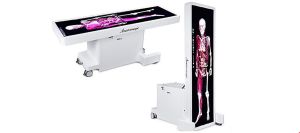Cabrini University has purchased a new 3D anatomy visualization system that will bring cutting edge technology to anatomy and physiology classes. The Anatomage Table will benefit approximately 600 science and nursing students each year, and is expected to be in use in the Iadarola Center by the fall 2020 semester.
The life-sized, interactive virtual dissection table was purchased with a $100,000 grant from the George I. Alden Trust.
The table rotates 90 degrees so that the human body can be viewed from the front, back or side. Technologically advanced software will allow for multiple views and simulations, according to Melinda Harrison, Ph.D., associate professor of chemistry and chair of the science department.
“I think with the addition of this table, not only is it going to advance our anatomy and physiology lab courses and make them more enriching and interesting for students and more real-world, as far as what the body really looks like beneath the skin, but it’s also going to be able to be utilized in other courses,” Harrison said. “So even if you’re not a nursing major and are a non-science major and you take a forensic science course, or a health and the human body course, these are courses where we plan to incorporate the table and students would have access to using it.”
Previously, students studying anatomy used plastic models of organs and bones or two-dimensional drawings. The Anatomage Table not only provides better images than these classroom aids, it has capabilities far beyond them.
“In the past, we would just have a model of an organ that the students would have to look at,” said Harrison. “By having this table, they can look at it in three dimensions and manipulate it while they’re actually taking the assessment.”
“I definitely feel like it’ll be more helpful because when I was taking Anatomy I, it was kind of hard to make the real connections between yourself and what you’re learning, and I feel like the virtual table will help with it,” Deanna Wyche, a junior pre-medicine biology major, said. “You’ll be able to look at it and say, okay, this is basically a human body, pretty much, and it’ll be more in depth versus just looking at a skeleton and trying to point it out.”

Sophisticated software enables the Anatomage Table to simulate histology slides, blood flow, certain types of injuries and diseases, the skeletal system, even embryonic development, according to Harrison. A tool called the virtual knife simulates the dissection process.
The variety of simulations available in the new 3D table will complement the Clinical Simulation Center used by the new Bachelor of Science in nursing program, which also begins in fall 2020.
“I think it’ll be a very good visual tool for [students] to really conceptualize the human body and how it functions normally and abnormally,” Jennifer Specht, Ph.D, founding director of the nursing program, said. “Cabrini students will have the state-of-the-art tools and technology that will prepare them for being a part of the healthcare workforce, whether it be in nursing, Allied Health or in the Sciences.”
The table allows images to be projected to a screen viewable by all students, not just those standing at the table. Features like this will change the way anatomy is taught in Cabrini classrooms.
“We’re hoping with this table that we’re going to be engaging students of varied learning abilities in a more diverse way,” Harrison said. “We all know that students learn in different ways. So by having this table, we’re hoping to visually stimulate students in different ways than we’ve been previously doing.”

The Anatomage Table’s technology is not available to undergraduates in most colleges, and makes Cabrini’s science programs more attractive to potential students, according to Harrison.
“We don’t have a lot of technology . . .for science majors, so I feel like it’s a big step in the right direction, especially for some of us who want to go to medical school,” said Wyche. “We’re getting more help that we need to be successful when we go on to grad school. I think it definitely makes Cabrini a more attractive school.”
“I think that we’ll definitely be competitive as far as our technology goes. I think having this table is going to really set us above those who don’t,” said Harrison. “I think it’s something that puts our students at an advantage. I’m really excited about it.”


